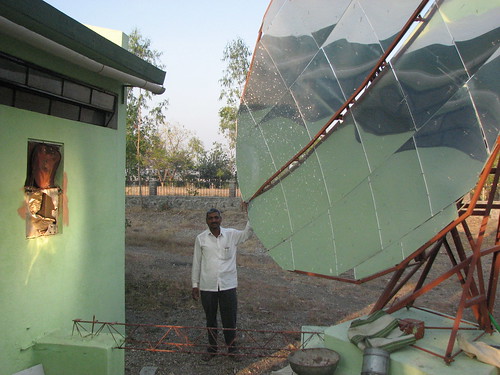India's will to renewable power
Posted by Big Gav in india
The Business Spectator has an interesting column on India's growing energy needs and their renewable energy potential - India's will to power.
Though blessed with an abundance of non-depleting renewable energy resources, India’s record in tapping them has been dismal.
Mercifully, of late, renewable sources are getting greater attention. But there is still a long way to go from the 4.9 per cent that renewable energy contributes to total energy generated. The official target is to increase this share to 10 per cent by 2012 and further in subsequent years. ...
Among renewable sources, geothermal energy which is derived from natural heat stored in the deep interior of the earth promises to be a key source. Except for a few half-hearted attempts, the government has done practically nothing to exploit this vast reserve.
By present reckoning, India has a geothermal power potential of 10,600MW, but the country is yet to see a single commissioned project that harnesses this technology. Though the capital cost for generating energy through geothermal is Rs80 million ($A2.46 million) to Rs100 million per MW, the operating cost is minimal. This is not adequately appreciated.
India's first geothermal company GeoSyndicate Power Private has been permitted to assess the potential through exploratory drilling, It recently signed a MoU with Panx Geothermal, an Australian geothermal venture, to exploit the Godavari basin and Ladakh geothermal provinces to generate power.
The various assessment studies and surveys undertaken so far have resulted in the identification of 340 hot springs across the country. The discovery of vast geothermal reservoirs at Puga in the north-west of the Himalayas and Tatapani fields on the Narmada in central India also augurs well for the country.
Another promising form of renewable energy in which India has a distinct advantage due to bright sunshine nearly 300 days in a year is solar energy. Globally, it is the fastest growing source of energy with an annual average growth of 35 per cent. In this too India’s record in tapping the resource has been lacklustre. Compared to China which is projected to have 86,100MWP (mega watt-peak)of solar photovoltaics and 1500MWP of solar thermal power by 2025, India is expected to be in a position to harness only a quarter of that in the same period.
A statement by Prime Minister Manmohan Singh on the eve of the climate-themed G-8 summit in Japan last July struck an optimistic chord. He said: “We will pool all our scientific, technical and managerial talents, with financial sources, to develop solar energy as a source of abundant energy to power our economy and to transform the lives of our people.” But the proof of the pudding still lies in its eating.
India’s first solar thermal power plant with a capacity to produce 100MW power is expected to be commissioned in a year by Acme Energy Solutions. The company claims that the cost of electricity produced by it would be around Rs 8 per unit, which would be among the lowest in the world for such a project.
Even in harnessing wind power, India, though a relatively early entrant, is only now beginning to break out of inertia. Despite the fact that wind power accounts for 6 per cent of India's total installed power capacity, it generates only 1.6 per cent of the country's power. As of July 2008 the installed capacity of wind power in India was 8,696MW. It is estimated that 6,000MW of additional wind power capacity will be installed in India by 2012.
Thanks to the rise of Suzlon – a leading global wind turbine manufacturer – India now has the fourth largest installed wind power capacity in the world, and is the wind energy leader in the developing world.
Another energy source with strong potential is biomass. Every day, tons of crop residue and waste from industries such as agro-industry and food processing industries like fruits and vegetable processing, dairy, sugar mills, hotels, slaughter houses, fisheries are generated. The available biomass has a potential of generating 30,000MW of power, though the needed investment to exploit this resource is largely absent.
Not all biomass is ignored, however. Cow dung is another source of fuel that is used extensively in Indian villages. Scientists have developed cow-dung gas plants which give methane gas for fuel and rich slurry with high content of nitrogen. The cost-benefit analysis of this type of gas plant shows that the investment is economical and the fuel is environment-friendly.






